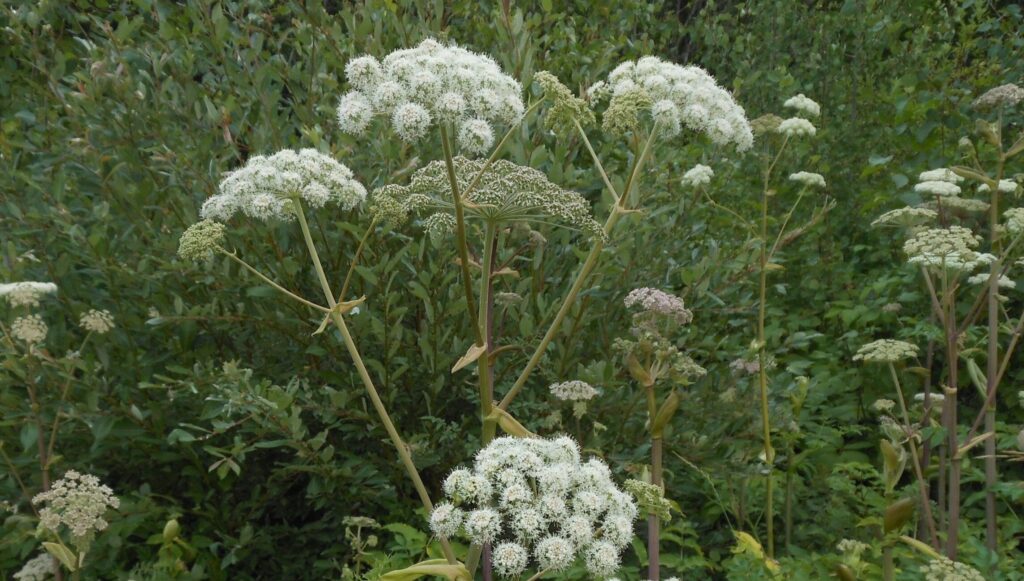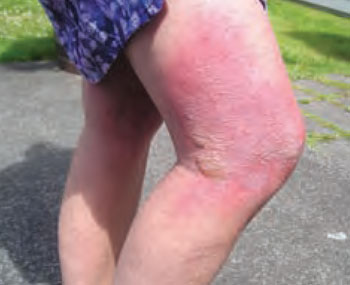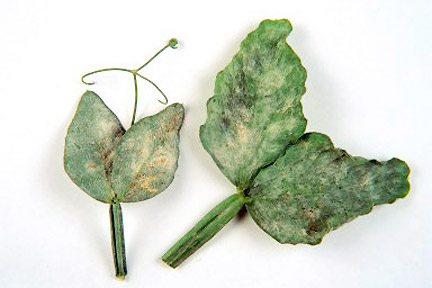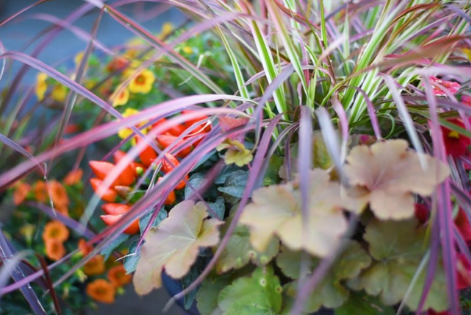
Giant Hogweed (Heracleum mantegazzianum), is a large herbaceous perennial plant in the carrot family. Originally from South Asia, it has been in Canada since the 1900s and is in every region of the country except the prairies.
Identifying Giant Hogweed

| Height: | Height: 2.5 to 5 m |
| Flowers: | Large, white umbrella-shaped flower clusters 30 to 90 cm across, made up of 50 to 150 small flower clusters |
| Leaves: | Prominently spiked edges Up to 1.5 m long. Leaflets grow right out of each side of the main stem, with no leaf stalk |
| Stem: | Hollow, 5 to 15 cm thick Prominent purple blotches. Distinct, coarse, bristly hairs |
| Origin: | Biennial (lives for two years) or perennial (lives longer than two years), Nonnative |
The clusters of white flowers are often mistaken as Queen Anne’s lace. However, Queen Anne’s Lace is a much smaller plant at one (1) metre tall whereas Giant Hogweed grows to 5.5 metres. See the photo below where the plant is almost as tall as the road sign. The flowers of Queen Anne’s lace are finer and more delicate than the flowers found on Giant Hogweed.

Giant Hogweed Flower is rounded and sturdier

Queen Anne’s Lace is flatter and more delicate
Why is Giant Hogweed Dangerous?
This is a dangerous plant because of its watery sap. The sap is in the hollow stems, the small reddish-purple flecks and stiff hair on the stems. This sap contains photosynthesizing compounds when once exposed to sunlight will cause skin burns. Symptoms of exposure to the sap and sun will show up within 48 hours and can blister. Although the sap will damage eyes there hasn’t been any evidence to confirm long term blindness.

4 days after exposure. Photo courtesy of Ont Invasive Species Plan
Growing Habits
It grows in ditches, alongside roads, in waterways and fields. It can overrun an area and little else will grow along with it. As a perennial, it will return yearly. It takes several years of growth before it will flower and go to seed. The flower stalks will appear in June through July and it will go to seed in August.

Giant Hogweed growing along a roadside ditch

Giant Hogweed is a monocarpic perennial meaning the plant will die once it flowers. Each plant can produce 50,000-120,000 seeds and the seeds can travel up to 10 metres. The seeds can remain viable in the soil for up to 15 years making the plant difficult to eradicate.

Giant Hogweed seedhead
Giant Hogweed has been identified as an invasive species by the Government of Ontario. According to the OMAFRA website, it has not been listed as an invasive species in any other Canadian province or in the United States. It is also listed as a noxious weed in Ontario. A noxious weed is considered to be harmful to the environment, animals and is subject to regulations such as the sale, transporting and removal of the plants.
What can I do about Giant Hogweed?
As contact with this plant can be a serious health hazard, extreme caution needs to be used when this plant is suspected. Learn how to identify Giant Hogweed to prevent yourself or especially children from accidentally coming in contact with it. What do you need to know if you suspect it is on your property? Due to its hazardous nature, do not burn it or try to remove it. Contact a professional exterminator who will safely remove and dispose of the plant material. If you suspect it is on public property, contact the Upper Thames Conservation Authority or the City of London to report the location of the plant(s). See the links below for more information and photos to help identify the plant.
The City of London has identified Giant Hogweed as a priority on it’s ‘watch’ list of invasive plants. Since it is a hazard to the public, it is eradicated when found on public land. Click on the link below to read the City of London’s Invasive Plant Management Strategy Report.
Helpful links:
Best Management Practices for Ontario – advice and fact sheets for all invasives – Ontario Invasive Plant Council
Ontario’s Invading Species Awareness program
City of London’s Invasive Plant Management Strategy Report.
Thames River Hogweed Fact Sheet





About The Author: Master Gardener
More posts by Master Gardener